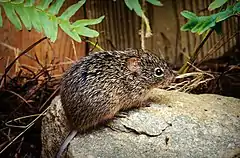| Sigmodontini | |||
| J.A. Wagner, 1843[1] | |||
 Przedstawiciel rodzaju – bawełniak szczeciniasty (S. hispidus) | |||
| Systematyka | |||
| Domena | |||
|---|---|---|---|
| Królestwo | |||
| Typ | |||
| Podtyp | |||
| Gromada | |||
| Podgromada | |||
| Infragromada | |||
| Rząd | |||
| Podrząd | |||
| Infrarząd | |||
| Nadrodzina | |||
| Rodzina | |||
| Podrodzina | |||
| Plemię |
Sigmodontini | ||
| Typ nomenklatoryczny | |||
| Synonimy | |||
|
| |||
| Rodzaje | |||
| |||
Sigmodontini – plemię ssaków z podrodziny bawełniaków (Sigmodontinae) w obrębie rodziny chomikowatych (Cricetidae).
Zasięg występowania
Plemię obejmuje gatunki występujące na terenie Ameryki Południowej, Ameryki Środkowej i w południowej części Ameryki Północnej[6][7].
Podział systematyczny
Do plemienia należy jeden występujący współcześnie rodzaj[8][6][9]:
Opisano również rodzaj wymarły:
- Prosigmodon Jacobs & Lindsay, 1981[10]
Przypisy
- 1 2 J.A. Wagner: Supplementband. W: J.Ch. Schreiber: Die Säugthiere in Abbildungen nach der Natur, mit Beschreibungen. Cz. 3. Erlangen: Expedition des Schreber’schen säugthier- und des Esper’schen Schmetterlingswerkes, 1843, s. 398. (niem.).
- ↑ O. Thomas. On the Genera of Rodents: an Attempt to bring up to Date the current Arrangement of the Order. „Proceedings of the Zoological Society of London”. 1896, s. 1019, 1896. (ang.).
- ↑ T.D.A. Cockerell, L.I. Miller & M. Printz. The auditory ossicles of American rodents. „Bulletin of the American Museum of Natural History”. 33 (28), s. 359, 1914. (ang.).
- ↑ Н.Н. Воронцов. Система хомяков (Сriсеtinае) мировой фауны и их филогенетические связи. „Бюллетень Московского Общества Испытателей Природы”. Отдел биологический. 64 (5), s. 136, 1959. (ros.).
- ↑ P. Hershkovitz: Mice, land bridges and Latin American faunal interchange. W: R.L. Wenzel & V.J. Tipton (redaktorzy): Ectoparasites of Panama. Chicago: Field Museum of Natural History, 1966, s. 747. (ang.).
- 1 2 C.J. Burgin, D.E. Wilson, R.A. Mittermeier, A.B. Rylands, T.E. Lacher & W. Sechrest: Illustrated Checklist of the Mammals of the World. Cz. 1: Monotremata to Rodentia. Barcelona: Lynx Edicions, 2020, s. 386–388. ISBN 978-84-16728-34-3. (ang.).
- ↑ U. Pardiñas, P. Myers, L. León-Paniagua, N.O. Garza, J. Cook, B. Kryštufek, R. Haslauer, R. Bradley, G. Shenbrot & J. Patton. Opisy gatunków Cricetidae: U. Pardiñas, D. Ruelas, J. Brito, L. Bradley, R. Bradley, N.O. Garza, B. Kryštufek, J. Cook, E.C. Soto, J. Salazar-Bravo, G. Shenbrot, E. Chiquito, A. Percequillo, J. Prado, R. Haslauer, J. Patton & L. León-Paniagua: Family Cricetidae (True Hamsters, Voles, Lemmings and New World Rats and Mice). W: D.E. Wilson, R.A. Mittermeier & T.E. Lacher (red. red.): Handbook of the Mammals of the World. Cz. 7: Rodents II. Barcelona: Lynx Edicions, 2017, s. 399–403. ISBN 978-84-16728-04-6. (ang.).
- ↑ N. Upham, C. Burgin, J. Widness, M. Becker, C. Parker, S. Liphardt, I. Rochon & D. Huckaby: Treeview of Mammalian Taxonomy Hierarchy. [w:] ASM Mammal Diversity Database (Version 1.11) [on-line]. American Society of Mammalogists. [dostęp 2023-10-06]. (ang.).
- ↑ Nazwy polskie za: W. Cichocki, A. Ważna, J. Cichocki, E. Rajska-Jurgiel, A. Jasiński & W. Bogdanowicz: Polskie nazewnictwo ssaków świata. Warszawa: Muzeum i Instytut Zoologii PAN, 2015, s. 255. ISBN 978-83-88147-15-9. (pol. • ang.).
- ↑ L.L. Jacobs & E.H. Lindsay. Prosigmodon oroscoi, a new sigmodont rodent from the late Tertiary of Mexico. „Journal of Paleontology”. 55 (2), s. 425, 1981. JSTOR: 1304228. (ang.).
Identyfikatory zewnętrzne (takson):
This article is issued from Wikipedia. The text is licensed under Creative Commons - Attribution - Sharealike. Additional terms may apply for the media files.